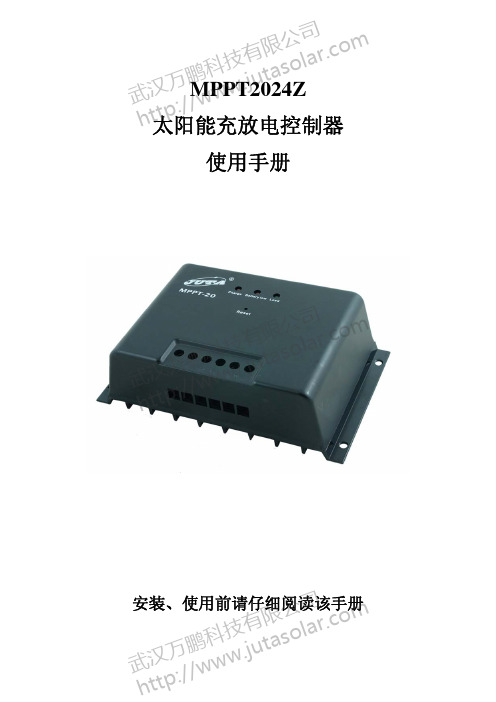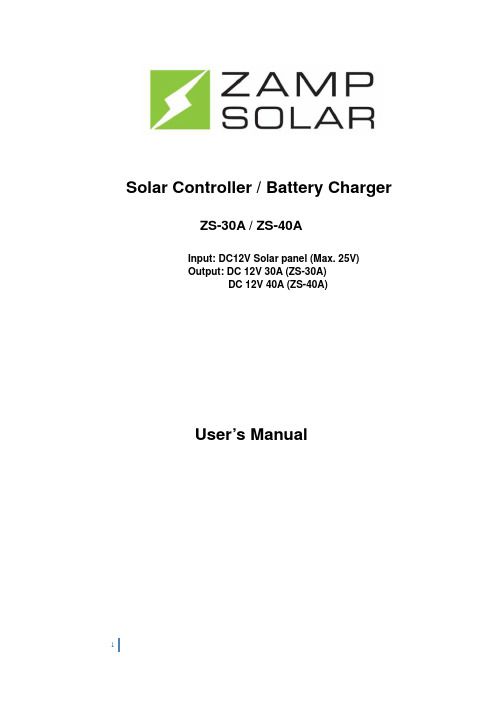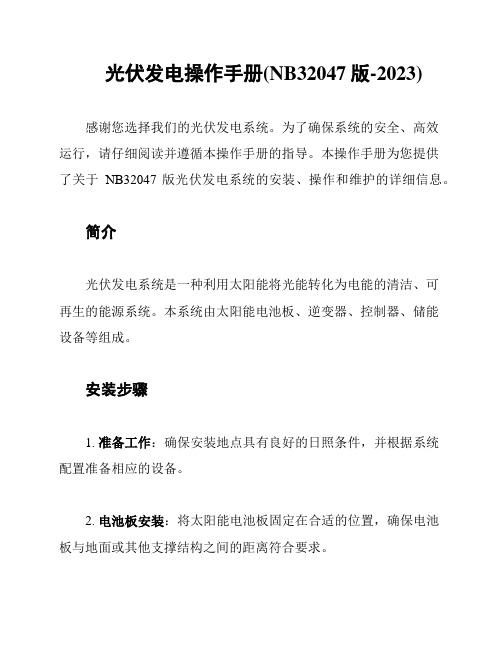太阳能电池板电池充电技术手册
MPPT2024Z 太阳能充放电控制器使用手册说明书

MPPT2024Z 太阳能充放电控制器使用手册安装、使用前请仔细阅读该手册 武汉万鹏科技有限公司 h t t p ://w w w .j u t a s o l a r .c o m 武汉万鹏科技有限公司 ht t p ://w w w.j u t a s o l a r .c o m 科技有限公司t a s o l a r .c o mMPPT2024Z 太阳能充放电控制器使用手册 版本V1.1目录 1. 安全事项............................................................................................................3 2. MPPT2024Z 控制器介绍.....................................................................................3 2.1 产品概述..................................................................................................3 2.2 产品结构..................................................................................................3 2.3 产品功能..................................................................................................4 2.4 最大功率点跟踪(MPPT)技术介绍......................................................6 3.系统规划参考....................................................................................................7 3.1 系统电压等级..........................................................................................7 3.2 太阳能电池配置......................................................................................8 3.3 配线..........................................................................................................8 3.4 过流保护..................................................................................................9 3.5 雷击保护..................................................................................................9 3.6 接地..........................................................................................................9 3.7 系统扩容..................................................................................................9 4.安装说明..........................................................................................................10 4.1 产品外形尺寸........................................................................................10 4.2 系统接线示意图....................................................................................11 4.3 线材工具准备........................................................................................11 4.4 安装过程................................................................................................11 5.使用说明..........................................................................................................12 5.1 按键功能说明........................................................................................12 5.2 LED 指示状态说明.................................................................................12 5.3 系统类型查看........................................................................................13 6.故障处理..........................................................................................................13 6.1 控制器保护后处理方法........................................................................13 6.2 常见故障现象及处理方法....................................................................14 7.技术参数..........................................................................................................15 8. 保修承诺. (16)武汉万鹏科技有限公司 h tt p ://w w w .j u t a s o l a r .c o m 武汉万鹏科技有限公司 ht t p ://w w w.j u t a s o l a r .c o m 科技有限公司 t a s o l a r .c o mMPPT2024Z 太阳能充放电控制器使用手册 版本V1.1尊敬的用户: 非常感谢您选用我们公司的产品!我们将为您的太阳能发电系统提供长久可靠的服务! 该手册提供产品的安装、使用、维护等相关的指导,使用前请仔细阅读该手册。
太阳能电池板智能充电器使用说明书

太阳能电池板智能充电器使用说明书充电及超压指示:当系统连接正常,且有阳光照射到光电池板时,充电指示灯(1)为绿色常亮,表示系统充电电路正常;当充电指示灯(1)出现绿色快速闪烁时,说明系统过电压,处理见故障处理内容;充电过程使用了PWM方式,如果发生过过放动作,充电先要达到提升充电电压,并保持30分钟,而后降到直充电压,保持30分钟,以激活蓄电池,避免硫化结晶,最后降到浮充电压,并保持浮充电压。
如果没有发生过放,将不会有提升充电方式,以防蓄电池失水。
这些自动控制过程将使蓄电池达到最佳充电效果并保证或延长其使用寿命。
蓄电池状态指示:蓄电池电压在正常范围时,状态指示灯(2)为绿色常亮;充满后状态指示灯为绿色慢闪;当电池电压降低到欠压时状态指示灯变成橙黄色;当蓄电池电压继续降低到过放电压时,状态指示灯(2)变为红色,此时控制器将自动关闭输出,提醒用户及时补充电能。
当电池电压恢复到正常工作范围内时,将自动使能输出开通动作,状态指示灯(2)变为绿色;负载指示:当负载开通时,负载指示灯(4)常亮。
如果负载电流超过了控制器1.25倍的额定电流60秒时,或负载电流超过了控制器1.5倍的额定电流5秒时,故障指示灯(3)为红色慢闪,表示过载,控制器将关闭输出。
当负载或负载侧出现短路故障时,控制器将立即关闭输出,故障指示灯(3)快闪。
出现上述现象时,用户应当仔细检查负载连接情况,断开有故障的负载后,按一次按键即恢复正常输出。
负载开关操作:控制器上电后默认负载输出为关闭,在正常情况下,每按一次按键,负载输出即改变一次开关状态。
当负载输出为开时,负载指示灯(4)常亮;当负载为关闭时,负载指示灯(4)常灭;当负载过载时,故障指示灯(3)慢速闪烁,当负载发生短路时,故障载指示灯(3)快速闪烁。
负载过载或短路控制器均会关闭输出。
第一次发生负载短路30秒后自动恢复输出若还没排出短路故障只能手动恢复输出。
如复位过载、短路保护,排出负载的短路或过载故障,按一次按键,即恢复正常输出。
太阳能充电器使用说明书

太阳能充电器使用说明书本产品是一款多功能太阳能应急充电器,内置1200mAh高容量可充电锂电池,可随时随地对您的手机、数码相机、PDA、MP3、MP4等数码产品进行充电。
造型华贵大方,小巧玲珑,携带方便,时尚高雅。
使用方法1、使用之前请给您的太阳能充电器充电,有三种方法可以选择:a、将充电器放置于太阳光直射处,太阳能将转化为电能给充电器内置可充电电池充电。
b、将充电器USB线连接电脑,此时充电器指示灯会闪光,表示正在充电,当充电满后,此灯将会熄灭。
C、用交流适配器充电,充电时指示灯会闪光,当充电满后此灯将会熄灭(因为设计有自动断电保护)2、将转换接头连接到延长线,再将延长线的另一头连接到充电器,或直接将转接头连接到充电器。
3、将转换接头连接到您的手机或其它数码产品。
4、从您的手机或其它数码产品上将可看到正在充电,充电的同时您也可以用手机通话。
5、太阳能充电指示。
将开关拨到‘NO’,太阳能板在接受阳光照射时,太阳能充电指示呈绿色。
产品特点:1、特别适用于应急场合。
当您在野外作业或旅游,或者遇到停电时,太阳能充电器将会帮您的大忙,使您的手机随时随地保持工作状态,让您不间断的与您的朋友和家人保持联系。
2、使用方便无论何时何地,您都可以极为方便的给您的手机或其它数码产品充电。
3、高效率充电给您的手机充电60分钟,可以获得100-150分钟通话时间4、环保、节约能源使用绿色能源太阳能,可为环保作出您的贡献。
5、外形时尚,携带方便造型简洁华贵,超薄不锈钢外壳设计,小巧玲珑,携带方便。
6、使用安全带有充电过充保护,有效延长您的手机电池的使用寿命,使用安全。
产品规格1、使用高转换效单晶硅或多晶硅片,太阳能转换效率高达15%以上。
2、太阳能电池板规格:5.5V/80mA。
3、充电时内置高容量可充电锂电池:1200 mAh。
4、输出电压:5.5V。
5、输出电流:1000mA。
6、充电器给手机充电时间:约60分钟(不同品牌和型号的手机有少许差别)。
ZS-30A ZS-40A 太阳能控制器 电池充电器用户手册说明书

Solar Controller / Battery ChargerZS-30A / ZS-40AInput: DC12V Solar panel (Max. 25V)Output: DC 12V 30A (ZS-30A)DC 12V 40A (ZS-40A)User’s ManualFor use with 12Volt Solar Panel OnlySuitable for Solar panels up to 510 Watts / ZS-30A; 680Watt / ZS-40ABattery Connection Solar Array ConnectionLength ofWire < 1m 6m 9m 12mPlease refer to the wire size chartbelow to determine the minimumsize wire needed for eachconnection. This will also ensureyou get the best performance outof your solar regulator.Soft Charge - When batteries suffer an over-discharge, the controller will softly rampsthe battery voltage up to 10V.Bulk Charge -Maximum current charging until batteries rise to Absorption levelAbsorption Charge-Constant voltage charging and battery is over 85%.Equalization Charge*-Only for WET battery or Calcium battery type, when the battery is deeply drained below 10V, it will automatically run this stage to bring the internal cells as an equal states and fully complement the loss ofcapacity.(LiFePO4, LTO,Gel and AGM battery do not run Equalization charge)Float Charge -Battery is fully charged and maintained at a safe level.A fully charged battery has a voltage of more than 13.6 Volts.The 6 LED’s indicate the charging status and thebattery conditionRed Blue Green Green Yellow Red Solar Power Present-Nobattery connectedON OFF OFF OFF OFF Flash Soft charging ON FlashOFF OFF OFF ON Bulk charging ON ON OFF Subject to battery voltage Absorption charging ON ON OFF ON OFF OFF Equalization charging ON ON OFF ON OFF OFF Float charging ON OFF ON OFF OFF OFF Solar panel weak FlashOFF OFF Subject to battery voltage At night no charge OFF OFF OFF Subject to battery voltageBattery Voltage below 11.5V(+/-0.2V)ON ON OFF OFF OFF ON Battery Voltage between 11.5V - 12.5V(+/-0.2V)ON ON OFF OFF ON OFF Battery Voltage above 12.5V(+/-0.2V) ON ON OFF ONOFF OFF.OPERATION - L.E.D. INDICATIONABNORMAL OPERATION MODEFlashFlashFlashOptional external Battery temperature sensor:As an option, the unit provides a port to connect the external battery temperature sensor; if。
Morningstar 25A 40A MPPT 太阳能充电器- 快速入门指南说明书

Scan QR Code to go directly to the ProStar MPPT Installation Manual and warranty information online.
Warning: Shock Hazard This unit is not provided with a GFDI device. This charge controller must be used with an external GFDI device as required by the Article 690 of the National Electrical Code for the installation location.
PC MeterBus Adapter (MSC)
1
ProStar MPPT™ Charge Controller
Caution: Equipment Damage
Do not expose the ProStar CC to weather. Locate in a dry, protected area to prevent equipment damage. Ensure the minimum clearance requirements are followed to provide adequate ventilation and prevent the unit from overheating.
Ferrite Chokes
Mounting Template
*A Menu Map is also included with metered versions, but is not shown in this guide.
太阳能电池充电器操作规程

太阳能电池充电器操作规程第一章:引言在建设可持续发展的社会的过程中,利用太阳能成为了一种重要的能源选择。
太阳能电池充电器作为一种绿色、环保的充电设备,正越来越被广泛应用。
为了确保太阳能电池充电器的安全运行,特制定本操作规程,旨在指导使用操作人员正确有效地操作太阳能电池充电器。
第二章:设备概述太阳能电池充电器是一种利用太阳能将光能转化为电能的设备。
它主要由太阳能电池板、电池充电器控制器和电池组成。
太阳能电池板负责将太阳光能转化为电能,充电器控制器负责控制电能的输出以及对电池进行充电。
第三章:使用条件1. 太阳能电池充电器主要适用于户外环境,确保充电器正面充分暴露在阳光下;2. 太阳能电池充电器的使用环境温度范围为-10℃至40℃,过低或过高温度可能影响充电器的性能;3. 太阳能电池充电器应远离易燃易爆、腐蚀性物质等危险环境;4. 充电器应放置在干燥通风的场所,防止受潮或者积水。
第四章:操作步骤1. 将太阳能电池充电器放置于阳光下,并确保太阳能电池板正面完全接触阳光;2. 若需要对电池进行充电,请将电池正确连接至充电器;3. 打开充电器控制器的电源开关,此时充电器将开始工作;4. 在充电过程中,及时观察充电器的LED指示灯,以了解充电器的工作状态;5. 当充电器的LED指示灯显示电池已充满,可以关闭电源开关,断开电池与充电器的连接,完成充电过程。
第五章:注意事项1. 在使用和操作太阳能电池充电器时,请仔细阅读操作手册,并按照说明进行操作;2、太阳能电池充电器仅适用于对符合要求的电池进行充电,禁止充电非指定电池;3、在操作充电器过程中,应注意充电器表面是否有结露或者异常发热现象,若有请立即断开电源开关并联系维修人员;4、禁止在高温条件下使用充电器,以免影响充电器的性能和寿命;5、在不使用充电器时,请将电源开关关闭,以免浪费太阳能电池板的电能。
第六章:维护与保养1、定期检查充电器电源和连接线路是否损坏,若有损坏应及时更换;2、保持充电器表面清洁,防止尘埃和杂物进入充电器内部;3、定期检查充电器的电池充电状态,并根据需要进行充电;4、若发现充电器工作异常,请立即断开电源开关,停止使用,并联系维修人员。
太阳能充电器的使用指南

太阳能充电器的使用指南随着科技的不断发展和环保意识的提高,太阳能充电器作为一种绿色能源的代表,越来越受到人们的关注和使用。
它利用太阳能将光能转化为电能,为我们的移动设备提供电力,同时减少对传统电网的依赖。
然而,对于很多人来说,太阳能充电器的使用还是一个相对陌生的领域。
本文将为大家介绍太阳能充电器的使用指南,帮助大家更好地利用太阳能充电器。
1. 太阳能充电器的工作原理太阳能充电器利用太阳能电池板将太阳能转化为电能。
太阳能电池板是由多个太阳能电池组成的,当阳光照射到太阳能电池板上时,光能被吸收并转化为电能。
这些电能会通过连接在太阳能电池板上的线路传输到充电器的电池中,从而为移动设备充电。
2. 太阳能充电器的适用范围太阳能充电器适用于户外活动、露营、徒步旅行等场景,尤其是在没有电源供应的地方。
它可以为手机、平板电脑、相机、手电筒等小型电子设备充电。
然而,需要注意的是,太阳能充电器的充电效率受到天气、光照强度和面积等因素的影响,因此在阴天或光照不足的情况下,充电效果可能会受到一定的影响。
3. 太阳能充电器的使用方法使用太阳能充电器非常简单,只需要按照以下步骤操作即可:步骤一:将太阳能充电器放置在阳光直射的地方,确保太阳能电池板能够充分吸收阳光。
建议将充电器放在平坦的地面上,以确保充电器的稳定性。
步骤二:将需要充电的设备连接到充电器的USB接口上。
一般来说,太阳能充电器会配备多个USB接口,方便同时为多个设备充电。
步骤三:等待设备充电。
在阳光充足的情况下,太阳能充电器可以快速为设备充电。
但需要注意的是,充电速度可能会受到设备电池容量和充电器输出功率的影响。
4. 太阳能充电器的使用注意事项在使用太阳能充电器时,需要注意以下几点:4.1 防水防尘:太阳能充电器通常用于户外环境,因此要选择具有防水防尘功能的充电器,以保护充电器不受到外界环境的影响。
4.2 避免高温:太阳能充电器在高温环境下可能会受损或过热,因此要避免将充电器暴露在阳光下或放置在高温的地方。
光伏发电操作手册(NB32047版-2023)

光伏发电操作手册(NB32047版-2023)感谢您选择我们的光伏发电系统。
为了确保系统的安全、高效运行,请仔细阅读并遵循本操作手册的指导。
本操作手册为您提供了关于NB32047版光伏发电系统的安装、操作和维护的详细信息。
简介光伏发电系统是一种利用太阳能将光能转化为电能的清洁、可再生的能源系统。
本系统由太阳能电池板、逆变器、控制器、储能设备等组成。
安装步骤1. 准备工作:确保安装地点具有良好的日照条件,并根据系统配置准备相应的设备。
2. 电池板安装:将太阳能电池板固定在合适的位置,确保电池板与地面或其他支撑结构之间的距离符合要求。
3. 逆变器安装:将逆变器安装在易于操作和维护的位置,并与电池板连接。
4. 控制器安装:将控制器安装在易于观察和操作的位置,并与电池板、逆变器等设备连接。
5. 储能设备安装:将储能设备安装在稳固的位置,并与控制器连接。
6. 系统调试:完成安装后,进行系统调试,确保各设备正常工作。
操作步骤1. 启动系统:打开控制器,检查各设备工作状态。
2. 充电操作:当阳光充足时,太阳能电池板开始充电。
3. 发电操作:电池板将光能转化为电能,通过逆变器将直流电转化为交流电。
4. 储能操作:多余的电能将储存在储能设备中,以备夜间或阴天使用。
5. 使用电能:通过家庭电路,将储能设备中的电能输送到家庭用电设备。
维护与保养1. 定期检查:每隔一段时间,检查电池板、逆变器、控制器等设备的工作状态。
2. 清洁电池板:定期清洁电池板表面的灰尘和污物,以保证电池板的最佳工作效率。
3. 检查连接线路:定期检查各设备之间的连接线路,确保连接正常,无损坏。
4. 维护储能设备:根据储能设备的说明书,进行定期的维护和保养。
故障处理1. 无法启动:检查控制器是否打开,各设备连接是否正常。
2. 充电异常:检查太阳能电池板表面是否有灰尘、污物,或损坏。
3. 发电异常:检查逆变器是否正常工作,电池板是否有损坏。
4. 储能异常:检查储能设备是否正常工作,连接线路是否有损坏。
- 1、下载文档前请自行甄别文档内容的完整性,平台不提供额外的编辑、内容补充、找答案等附加服务。
- 2、"仅部分预览"的文档,不可在线预览部分如存在完整性等问题,可反馈申请退款(可完整预览的文档不适用该条件!)。
- 3、如文档侵犯您的权益,请联系客服反馈,我们会尽快为您处理(人工客服工作时间:9:00-18:30)。
Tiny 2-Cell Solar Panel Charges Batteries in Compact, Off-Grid DevicesDesign Note 491Fran Hoffart06/11/491Figure 1. Solar Panel Output Voltage, Current and PowerIntroductionAdvances in low power electronics now allow placement of battery-powered sensors and other devices in locations far from the power grid. Ideally, for true grid independence, the batteries should not need replacement, but instead be recharged using locally available renewable energy, such as solar power. This Design Note shows how to produce a compact battery charger that operates from a small 2-cell solar panel. A unique feature of this design is that the DC/DC converter uses power point control to extract maximum power from the solar panel.The Importance of Maximum Power Point ControlAlthough solar cells or solar panels are rated by power output, a panel’s available power is hardly constant. Itsoutput power depends heavily on illumination, temperature and on the load current drawn from the panel. To illustrate this, Figure 1 shows the V-I characteristic of a 2-cell solar panel at a constant illumination. The I-vs-V curve features a relatively constant-current characteristic from short-circuit (at the far left) to around 550mA load current, at which point it bends to a constant-voltage characteristic at lower currents, approaching maximum voltage at open circuit (far right). The panel’s power output curve shows a clear peak in power output around 750mV/530mA, at the knee of the I-vs-V curve. If the load current increases beyond the power peak, the power curve quickly drops to zero (far left). Likewise, light loads push power toward zero (far right), but this tends to be less of an issue.Of course, panel illumination affects available power—less light means lower power output; more light, more power. Although illumination directly affects the value of peak power output, it does not do much to affect the peak’s location on the voltage scale. That is, regardless of illumination, the panel output voltage at which peak power occurs remains relatively constant. Thus, it makes sense to moderate the output current so that the solar panel voltage remains at or above this peak power voltage, in this case 750mV. Doing so is called maximum powerpoint control (MPPC). Figure 2 shows the effects of varying sunlight on the charge current, with maximum power point control and without. The simulated sunlight is varied from 100% down to approximately 20%, then back up to 100%. Note that as the sunlight intensity drops about 20%, the solar panel’s output voltage and current also drop, but the LTC3105 maximum power point control prevents the panel’s output voltage from dropping below the programmed 750mV. It accomplishes this by reducing the LTC3105 output charge current to prevent the solar panel from collapsing to near zero volts, as is shown in the plot onthe right side of Figure 2. Without power point control,a small reduction in sunlight can completely stop chargecurrent from flowing.L TC3105 Boost Converter with Input Power Control The LTC3105 is a synchronous step-up DC/DC converter designed primarily to convert power from ambient energy sources, such as low voltage solar cells and thermoelectric generators, to battery charging power. The LTC3105 uses MPPC to deliver maximum available power from the source. It accomplishes this by reducing the LTC3105 output cur-rent to prevent the solar panel from collapsing to near zeroL , L T , L TC, L TM, Linear Technology, the Linear logo and Burst Mode are registered trademarks of Linear Technology Corporation. All other trademarks are the property of their respective owners.DN F01SOLAR PANEL OUTPUT POWER (mW)6005004003002001000400300200100SOLAR PANEL OUTPUT VOL TAGE (mV)S O L A R P A N E L O U T P U T C U R R E N T (m A )LINEAR TECHNOLOGY CORPORA TION 2011dn491 LT/AP 0611 226K • PRINTED IN THE USALinear Technology Corporation1630 McCarthy Blvd., Milpitas, CA 95035-7417(408) 432-1900 ● FAX : (408) 434-0507 ● Figure 3. 2-Cell Solar Panel Li-Ion Battery ChargerFigure 2. Changing Sunlight Intensity Effects on Charge Currentvolts. The LTC3105 is capable of starting up with an input as low as 250mV, allowing it to be powered by a single solar cell or up to nine or ten series-connected cells. Output disconnect eliminates the isolation diode often required with other solar powered DC/DC converters and allows the output voltage to be above or below the input voltage. The 400mA switch current limit is reduced during start-up to allow operation from relatively high impedance power sources, but still provides sufficient power for many low power solar applications once the converter is in normal operation. Also included are a 6mA adjustable output low dropout linear regulator, open-drain power good output, shutdown input and Burst Mode ® operation to improve efficiency in low power applications.Solar-Powered Li-Ion Battery ChargerFigure 3 shows a compact solar-powered battery charger using a LTC3105 as a boost converter and a LTC4071 as a Li-Ion shunt charger. A 2-cell 400mW solar panel provides the input power to the LTC3105 to produce over 60mA of charge current in full sunlight. Maximum power point control prevents the solar panel voltage from dropping below the 750mV maximum power point, as shown in Figure 1. The converter’s output voltage is programmed for 4.35V, slightly above the 4.2V float voltage of the Li-Ion battery. The LTC4071 shunt charger limits the voltage across the battery to 4.2V. Grounding the FBLDO pin programs the low dropout regulator to 2.2V, which powers the “charging” LED. This LED is on when charging and off when the battery voltage is within 40mV of the float voltage, indicating near full charge. An NTC thermis-tor senses battery temperature and lowers the LTC4071 float voltage at high ambient temperatures for increased battery safety. To prevent battery damage from over-discharge, the low battery disconnect feature disconnects the battery from the load if the battery drops below 2.7V. Conclusion Although the circuit described here produces only a few hundred milliwatts, it can provide enough power to keep a 400mAhr Li-Ion battery fully charged under most weather conditions. The low input voltage, combined with input power control, makes the LTC3105 ideal for low power solar applications. In addition, the LTC4071 shunt charging system complements the LTC3105 by providing the precision float voltage, charge status and temperature safety features to assure long battery life in outdoor environments.www.linear .comFor applications help, call (408) 432-1900, Ext. 372510 SECONDS6004002000604001.00.80.40.60.20DN F02(WITH MAXIMUM POWER POINT CONTROL)SOLAR PANEL OUTPUT (V)P A N E L O U T P U T (m A )C H A R G E C U R R E N T (m A )BATTERY VOL TAGE = 3.6V20 SOLAR PANEL OUTPUT CURRENT SOLAR PANELOUTPUT VOL TAGERELATIVE SUNLIGHTINTENSITYL TC3105CHARGE CURRENT 100%100%C H A R G E C U R R E N T (m A )60040020006040200 1.00.80.40.60.2(NO MAXIMUM POWER POINT CONTROL)SOLAR PANEL OUTPUT CURRENTRELATIVE SUNLIGHTINTENSITY SOLAR PANEL OUTPUT (V)P A N E L O U T P U T (m A )100%100%DN F03I SC = 600mA,V OC = 1VTEMPERATURE TRACKING,。
